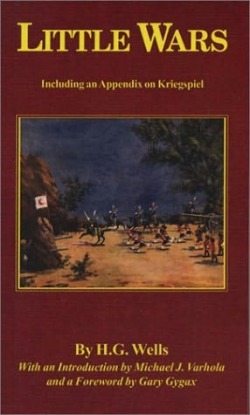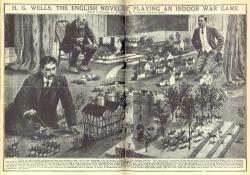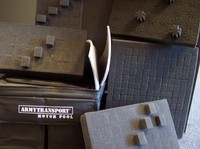|
April 29th, 2010
Review Toy Soldiers 101: Little Wars Our wargaming hobby dates back to as far back as the first hollow cast metal toy soldiers. It's even said that Napoleon played with and collected toy soldiers. I even recently happened upon a video of British actor Peter Cushing (of Hammer Horror films, and Grand Moff Tarkin of StarWars fame) painting and playing with his toy soldiers, from what looks like the 1960s in the video. At the end of the video lays a copy of the book Little Wars and a yardstick.
The same sci-fi visionary responsible for the literary masterpieces The War of the Worlds, The Invisible Man, The Island of Doctor Moreau and The Time Machine, also just happens to be the great grand-daddy of wargames too. In 1911 H. G. Well wrote Little Wars, which is by many considered to be the first rulebook for the modern day wargame utilizing toy soldiers. The actual title is... Little Wars: a game for boys from twelve years of age to one hundred and fifty and for that more intelligent sort of girl who likes boys' games and books I'll be honest, I never bothered to read it, until recently. I was really impressed and amazed by this one little book once I did read it. I'd have to say that it's a must read for any wargaming enthusiast. It's hard to believe that as far back as 1911 even, grown middle aged men would throw their children out of their rooms, to get away from their wives, and then get down on the floor and seriously play with tin toy soldiers together. The ingenuity of Wells, impressed me as I read on. They were using toy blocks, stacks of board, even encyclopedias to represent hills and cliffs, they hated carpeting since toy soldiers didn't stand well on it, and they even tried to make their countryside as realistic looking as possible by drawing windows and doors on their would be houses, churches and other structures made of wood and folded paper even.
They had the same imagination and determination of today's' wargaming enthusiast, and faced the same challenges, like significant others thinking we're crazy, and some going as far as being upset that grown men are playing with toys on the living room floor, or dining room table. I think this may be where the need of the modern day Man Cave was first envisioned too! As Wells began to create his rules, it's clear that the same issues present in today's wargames existed then. He didn't want to allow a troop to shoot a cannon and move it at the same time, and he wanted those pieces that could utilize a cannon, to be in groups of 4-6 men. To even shoot 4 men had to be within six inches of it. They even timed the turns, so that it didn't take forever for each side to get their turn in. This is something I think many games should re-adopt today. Wells even faced the need of reiterating and refining of the rules, due to issues that arise and that need clarified, to avoid the modern day "game breaking" rule exploitation. I found it amusing that they would hang a curtain over the middle of the playing field to deploy, so they couldn't see what the other side was doing. We've done this before during Apocalypse Warhammer 40k battles to make deployment fair and more realistic too, to create that fog of war usually absent from wargames of today. They used the curtain as an "if available" option tho. A coin toss would otherwise help to determine setup. They used a third party timekeeper to keep track of the time players were allowed to take even, and the time taken was based on how many pieces each side had, and this would change as the game progressed and pieces were killed off. For 1911 this was a pretty complex little system. They used a two foot piece of string, and a six inch piece of string to judge proper movement of troops, artillery guns and cavalry, and to make sure that troops are within proper range of a gun, for that gun to not be abandoned. Troops moved 12-inches, cavalry the full two feet and guns were limited by what units be it cavalry, or troops we're moving it. Of course the difference is that they used projectile firing toy guns to knock over the tin soldiers with bits of wooden dowel and other objects fired from the toy guns, and not dice yet. If a soldier is knocked over it's dead. Quite simple enough. Close combat even involved the taking of prisoners. The book even offers some of the first ever wargame Battle Reports, in detail. Here's a link to a free public downloadable version of Little Wars in .pdf format. It's not a long book at all, about 32 pages is all, and it's worth a read if you want to see the game that pretty much started it all. There's also a section at the end on Kriegspiel (German for Wargame, and is a variant of chess), and how to adapt it to be a used as a military training tool. Reading through the rules H. G. Wells created, one can clearly see the foundation of where almost every wargame rule set today in some way, shape or form originated from. It's also pretty ironic that such a well know pacifist, took the time and effort to put together a fairly complex (for 1911) wargame. Wells authored another book called Floor Games around the same time, which some consider a companion book to Little Wars. It's original description is as follows... An book chock full of ideas for creating tales and scenes using toy soldiers, miniature animals, blocks, and trains and train tracks. I may need to dig that one up too, and give it a read. The last known publishing of Little Wars was in 2004 by by Skirmisher Publishing LLC, and includes an introduction by game designer Michael J. Varhola, and a foreword by Dungeons and Dragons co-creator, and RPG gaming legend Gary Gygax. If you're looking for a hardcopy, that's the one to look for. |
|

|
|
- Home
-
Reviews
- Interview - Matt Wagner/Eagle Dynamics
- Interview - Polychop Simulations
- Review - MonsterTech HOTAS Table Mounts
- Review - Rebel Galaxy Outlaw
- Review - EVGA 2080 Super Black Gaming 8GB Video Card
- Review - ASUS VG49VQ 49 Inch Super Ultra Wide Gaming Monitor
- In Focus Review - Heatblur's F-14 Tomcat Module for DCS World
- Classic Review - Jetfighter III
- Review - Thrustmaster T.Flight Rudder Pedals
- Review - Thrustmaster HOTAS WARTHOG Joystick
- First Impressions - DCS World High Fidelity Modules
- Classic Review - Suncom Strike Fighter Series Throttle
- Classic Review - F-22 Pro Joystick from Thrustmaster
- Classic Review - EuroFighter 2000
- In Focus Review - DCS World Persian Gulf Map Module
- Classic Review - US NAVY Fighters
- Review -TrackIR 5 from NaturalPoint
- Review - Thrustmaster T16000M FCS HOTAS
- Classic Review - Jane's AH-64D Longbow
- In Focus Review - DCS World Revisited: Diving off the Flaming Cliffs
- In Focus Review - State of Flight-Sims and HOTAS Games 2019
- Review - Flamberge/Jumping Atlas/WASP WSP-1 Models from Iron Wind Metals
- Review - Star Trek Starships Collection
- Review - Knight Models Arkham City Bane 35mm Model
- Review - Knight Models Man of Steel & Frank Miller Batman 35mm Models
- Review - Mecha Zone 2: The Art of David A White
- In Focus Review - SuperSystem 3rd Edition
- In Focus Review - Heavy Gear: Arena Two-Player Starter Set
- Review - JUNK: Dogface Combots from Grindhouse Games
- In Focus Review - ShadowSea from AntiMatter Games
- Review - TRO 3085 Lance Pack
- Review - Technical Read Out 3085 & Record Sheets 3085
- In Focus Review - JR Miniatures 25mm Medieval Structures
- In Focus Review - Dust Tactics
- In Focus Review - War Rocket
- In Focus Review/Interview - Plasma Blast Games 6mm Sci-Fi Models
- Review - PortableWarfare Sergeant Case
- Review - Steel Warriors
- Review - Having Good Hex: Hex Bases 101
- Review - Xmarx & Old Crow 6mm Sci-Fi Models
- Review - BattleTech Mech Models
- In Focus Review - BattleTech
- Review - Song Of Our Ancestors
- In Focus Review - BattleTech Total Warfare Core Rulebook
- Review -Rosemary & Co Brushes
- Review - Q-Workshop Pirate & Sniper Dice
- Review - HiTech Miniatures SF Commander & 25mm Resin Bases
- Review - Tengu Models
- Review - Atomic Super Humans
- In Focus Review - Warlord 2nd Edition/Savage North
- Review - The Complete Guide to Miniature Painting
- Review - JR Miniatures 15mm Scale Terrain
- Review - HellDorado LOST Starter Set Review
- Review - Heavy Gear: Black Talon Return to Cat's Eye
- Review - Mantic Games Dwarfs Iron Belcher Cannon Review
- Review - Heavy Infantry/Kolony Feral HQ Models
- Review - HellDorado Westerners Starter Set
- In Focus Review - Heavy Gear Interpolar War 2-Player Starter Set
- Review - Micro-Art Studio Hive/Power Plant and Ruins Bases
- Review - Wargames Factory Shock Troops Models
- Review - Mantic Games Dwarfs IronClad Regiment
- Review - Mantic Games Dwarfs Ironwatch Troop
- Review - MERCS Minis FCC Models
- In Focus Review - Incursion board game from Grindhouse Games
- Review - Incursion Models from Grindhouse Games
- Review - MERCS Minis USCR Models
- In Focus Review - AE Bounty from Darkson Designs
- Review - AE Bounty Starter Set Models
- Review - Micro-Art Studio Great Wolves
- Review - Kabuki Models Revisited
- In Focus Review - Eden Post Apocalyptic Skirmish Game
- Review - Soda Pop Miniatures Models
- In Focus Review - Warpaints Wargaming Starter Paints Set
- Review - Freebooter's Fate: Crew Expansion Models
- In Focus Review - Quantum Gothic Part III
- Review - Ron & Bones Undead/Skeleton Models
- Review - Zynvaded Starter Set
- In Focus Review/Interview - Reaper Miniatures, Inc
- Review - Armory Primer
- Review - Pulp City Models
- In Focus Review - Bob Smith Industries CA Adhesives
- In Focus Review - Derivan MiNiS Paints
- In Focus Review - MaxMini Models & Bitz
- In Focus Review - Studio Miniatures Models
- Review - Q-Workshop's Forest & Celtic Dice Sets
- In Focus Review - The Army Painter QuickShade
- In Focus Review - da Vinci paint brushes
- In Focus Review - Ramshackle Games Post Apocalyptic Models
- In Focus Review - Brotherhood of Assassins
- In Focus Review - Flames of War - Dogs and Devils Campaign Book
- In Focus Review - Flames of War: Open Fire Starter Set
- In Focus Review - Wardroids
- In Focus Review - Coat D' Arms Acrylic Paints
- In Focus Review - HeroScape Dungeons & Dragons Master Set 3 - Battle for Underdark
- In Focus Review - Dice of the Dead
- In Focus Review - Please Stand By
- In Focus Review - Fear And Faith
- In Focus Review - Filla-Glu
- First Look Preview - AE Bounty
- In Focus Review - The Army Painter Brushes
- In Focus Review - Crooked Dice Game Design Studio
- In Focus Review - Quantum Gothic Revisited
- Preview - Judge Dredd
- In Focus Review - Tannhauser Revised Edition
- In Focus Review - Freebooter's Fate
- Preview - Dust Tactics/City of Thieves
- In Focus Review - Mutants and Death Ray Guns
- In Focus Review - Song of Blades and Heroes
- PC Hardware Review - Saitek X-52 Pro HOTAS
- In Focus Review - Knight Models: Star Wars 30mm Models
- PC Review - Wings of Prey
- In Focus Review - Pig Iron Productions Kolony Feral Squad & Specialists
- In Focus Review - Q-Workshop Dice
- PC Review - Torchlight
- Review - The Adventurers
- In Focus Review - Mantic Games: Introduction to the Undead
- In Focus Review - Red Ops 5
- In Focus Review - All Things Zombie: Better Dead Than Zed
- In Focus - The Coolest Game You'll Probably Never Play!
- In Focus Review - Atlas Brush Company, Inc.
- In Focus Review - Ziterdes Models
- In Focus Review - Micro-Art Studios
- In Focus Review - Faction Wars
- PC Review - Warhammer 40k: Dawn of War II Chaos Rising
- In Focus Review - Pegasus Models
- Classic Review: Mage Knight 2.0
- Review In Focus: Quantum Gothic
- PC Review: Airstrike Eagles of World War II
- In Focus Review - Avatars of War & Arena DeathMatch
- Review In Focus: Windsor & Newton
- First Look Preview: Kabuki Models
- Classic Review: How to paint Citadel Miniatures
- Review: Pig Iron System Troopers/Kolony Militia
- Classic Review: In Focus ESLO Terrain
- In Focus Review: MERCS YellowJackets & KemVar
- Review: Toy Soldiers 101: Little Wars
- Review: Warmachine Plastic Heavy Warjack kits
- Editorial: State of the Game Warhammer 40k
- P3 Model Drilling & Pinning Set
- Review: Miniature Paints 101
- Review: Kabuki Models 21st Century Pinups & Dark Messiah
- Review: Cool Wargame tools
- Classic Review: Warmachine 2003
- Retribution of Scyrah Overview
- Classic Review: Lord of the Rings Return of the King Strategy Battle Game
- Classic Review: Dogs of War
- Review: Sabol Monthy Deals
- Want your product covered?




